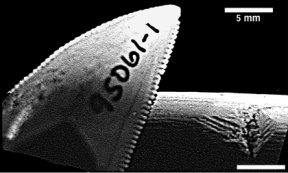Family Meal: Cannibal dinosaur known by its bones
Some carnivorous dinosaurs routinely fed on their own species, according to an analysis of scarred fossils. Paleontologists contend the ancient gnaw marks are among the strongest evidence yet that some dinosaurs indeed were cannibals.


Majungatholus atopus was a 9-meter-long theropod that strolled the plains of Madagascar, the large island off southeastern Africa, about 70 million years ago. The dinosaur’s size and its meat-shearing teeth mark the species as a top predator, says Raymond R. Rogers, a paleontologist at Macalester College in St. Paul, Minn.
The edges of Majungatholus‘ bladelike teeth, like those of many carnivores, sport denticles. These tiny, chisel-like features provide a serrated edge that can leave minuscule grooves on gnawed bones. At Madagascan fossil sites containing Majungatholus remains, many bones bear such grooves. And in more than 20 cases, says Rogers, it’s the bones of M. atopus that are so scarred.
The denticle grooves on several Majungatholus bones were, on average, spaced about 0.48 millimeter apart. Rogers and his colleagues, who present their analysis in the April 3 Nature, found that the denticles on 10 randomly selected Majungatholus teeth had a spacing of 0.5 mm. Also, parallel tooth marks left by one bite indicate that the chewer had teeth spaced between 10 and 17 mm apart, a measurement also emblematic of Majungatholus.
No other carnivore known in the ancient ecosystem could have left these marks, says Rogers. The only other theropod dinosaur found to inhabit Madagascar at the time was the 1.8-m-long Masiakasaurus knopfleri (SN: 1/27/01, p. 52: Available to subscribers at Rock guitarist inspires rock hounds), whose teeth and bite were too small to make these traces. The teeth of the two large crocodile species known to live then were too blunt and too irregularly spaced to have produced the narrow grooves found on the Majungatholus bones.
“If the [denticle] marks weren’t made by Majungatholus, they were made by an unknown animal with teeth just like theirs,” says Thomas R. Holtz Jr., a vertebrate paleontologist at the University of Maryland in College Park.
Scientists often gain insight into the behavior of extinct animals through analyses of so-called trace fossils, such as tooth marks or footprints (SN: 6/9/01, p. 362: Beyond Bones). Although the fossil evidence suggests that Majungatholus ate its kin, it’s unclear whether the creature preyed on its relatives or scavenged their remains.
Evidence for true cannibalism among dinosaurs is equivocal, says Rogers. Other analyses of chewed bones suggest that tyrannosaurs often ate tyrannosaurs, but the teeth marks aren’t distinctive enough to determine whether victim and predator were members of the same species. Also, Rogers notes, some paleontologists are questioning earlier claims of cannibalism among Coelophysis bauri, a theropod species for which dismembered remains of juveniles turned up seemingly within the rib cages of adults.
Cannibalism in dinosaurs wouldn’t be surprising, says Hans-Dieter Sues, a paleontologist at the Carnegie Museum of Natural History in Pittsburgh. Many reptiles today, including crocodilians and Komodo dragons, regularly prey on their own species, he notes.
****************
If you have a comment on this article that you would like considered for publication in Science News, send it to editors@sciencenews.org. Please include your name and location.
To subscribe to Science News (print), go to https://www.kable.com/pub/scnw/
subServices.asp.
To sign up for the free weekly e-LETTER from Science News, go to http://www.sciencenews.org/subscribe_form.asp.







